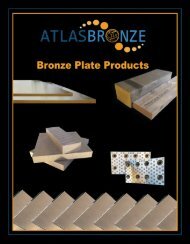You also want an ePaper? Increase the reach of your titles
YUMPU automatically turns print PDFs into web optimized ePapers that Google loves.
Methods of Manufacture<br />
Continuous Cast Process<br />
Continuous casting is a process in which<br />
solidifying metal is extracted through an open<br />
ended mold fitted with a cooling unit. Heat is<br />
extracted and the metal exits the mold as a solid<br />
with a constant cross section. It allows lower<br />
cost production of metal sections with better<br />
quality, due to finer control through automation<br />
of the casting process. Generally a saw is set<br />
up after the withdrawal rolls, in order to cut the<br />
casting at constant lengths. The castings are<br />
semi-finished products.<br />
Continuous<br />
Cast Vertical<br />
Withdrawal<br />
Rolls<br />
Metal<br />
Graphite<br />
Die<br />
Water<br />
Cooling<br />
Jacket<br />
Automatic<br />
Saws<br />
Automatic<br />
Saws<br />
Withdrawal<br />
Rolls<br />
Water<br />
Cooling<br />
Jacket<br />
Continuous<br />
Cast Horizontal<br />
Graphite<br />
Die<br />
Metal<br />
Centrifugally Cast Process<br />
Centrifugal casting is done by pouring molten<br />
metal into a rotating mold. The centrifugal force<br />
acting on the mold helps in feeding and positioning<br />
the metal in the mold. Mold rotation is continued<br />
until after the metal is solidified. Centrifugal casting<br />
results in denser and cleaner metal as heavier<br />
metal is thrown to parts of the mold away from the<br />
center of rotation and the lighter impurities like<br />
slag, oxides and inclusion are squeezed out to the<br />
center. The castings produced have a close grain<br />
structure, good detail, high density and superior<br />
mechanical properties.<br />
Horizontal<br />
Centrifugal Casting<br />
Vertical<br />
Centrifugal Casting<br />
Metal<br />
2<br />
Wrought Alloys<br />
Extrusion is the process by which long straight<br />
metal parts can be produced. The cross-sections<br />
that can be produced vary from solid round,<br />
rectangular, to L shapes,Tshapes,Tubes and<br />
many other different types. Extrusion is done by<br />
squeezing metal in a closed cavity through a tool,<br />
known as a die using either a mechanical or<br />
hydraulic press. There are two main types of<br />
Extrusions: Hot Extrusions and Cold Drawn. The<br />
forging process involves working metal parts above<br />
their recrystallization temperature and gradually<br />
shaping them into the desired configuration through<br />
the hammering or pressing of the work piece.<br />
Hot Extrusion<br />
Forging - Open Die Process<br />
Forging - Closed Die Process<br />
Die<br />
Metal<br />
Metal<br />
Side View<br />
Metal<br />
Force Pulling Force Metal<br />
Metal<br />
Die<br />
Water Cooled Mold<br />
Die<br />
Cold Drawn Process<br />
Plain View<br />
Metal<br />
Hot Roll Process<br />
Metal<br />
Die<br />
Smooth<br />
Rollers<br />
Water<br />
Cooling




